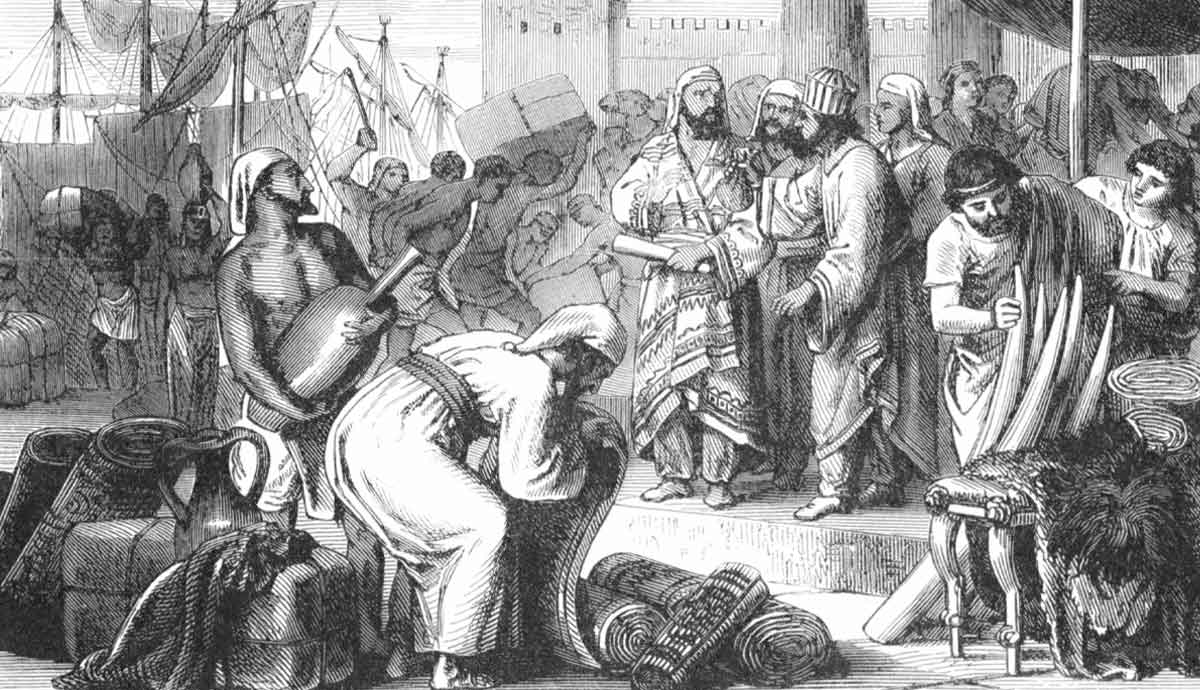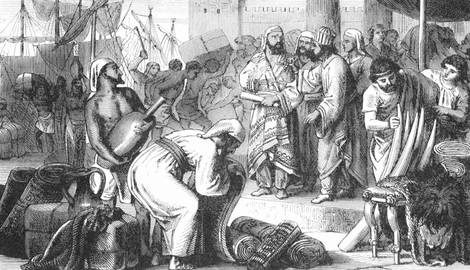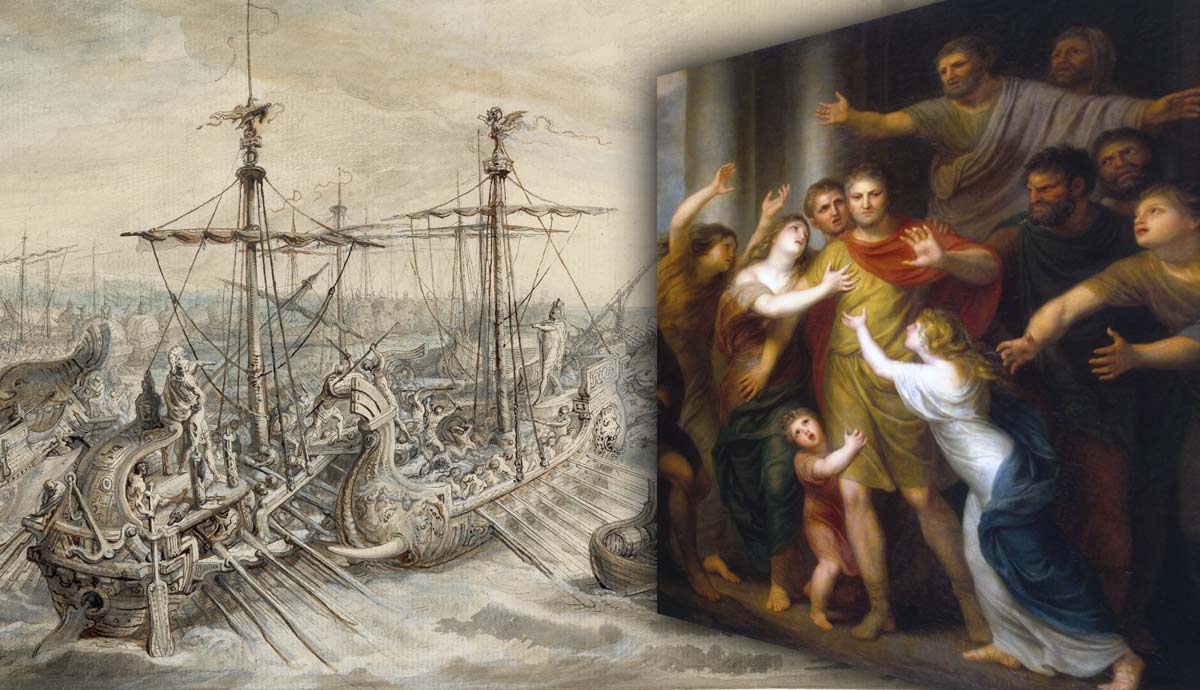
The Phoenicians, renowned for their trading and maritime skills, originated in what’s modern Lebanon. They called themselves Canaanites, related to similar peoples in the region. The term Phoenician derived from the Greek word “phoinix” meaning purple, referencing the famous purple dye produced in Tyre.

The Phoenician era spanned some 2,500 years, encompassing both the Bronze and Iron Ages. Their first cities began trading about then. Three Phoenician cities—Tyre, Sidon, and Byblos — appeared during the Bronze Age. As the Phoenicians sailed across the Mediterranean Sea, they established settlements at strategic locations for economic or maritime control. Each ruled independently with a king or oligarchy, competed against the others. The greatest of Phoenicia’s cities would be Carthage.
The Big Three of the Phoenician Heartland

The original city-states started in what’s now Lebanon, called Canaan by the Phoenicians. These cities, nominally grouped under Phoenicia, in fact acted more like a loose network, often rivals but banded together when needed. Canaan’s big three, while not always the biggest, reigned perhaps the most important. From these economic and cultural centers, the Phoenicians spread across the Mediterranean. This expansion chased economics, not politics. However, these traders made political alliances as needed.
Byblos: The First

First settled circa 8800, with the city forming around 3300 BCE, making Byblos one of the world’s oldest continually inhabited cities. Called Gebal by the Phoenicians, Byblos emerged as the Phoenician cultural and spiritual center. The temple of Baalat Gebal or “Lady of Byblos”, one of Phoenicia’s celebrated deities, was built around 2800 BCE. Byblos’s religious reputation even spread to the Egyptians. The slain Egyptian god Osiris’s boat drifted to Byblos, where the people reportedly entombed him in a temple dedicated to Isis.
Byblos’s greatest cultural innovation was the Phoenician alphabet. This script revolutionized writing with just twenty-two characters. A simplified system allowed for fast transactions and record-keeping, spreading quickly as the Phoenicians traveled around the Mediterranean. As one of Phoenicia’s trading powerhouses, Byblos traded papyrus, cedar, and goods to Egypt and further.
Sidon: The Seat

Sidon, a second of Phoenicia’s three great city-states, is thought to mean “fishery” in the local Semitic languages. Located only twenty-five miles north of modern Beirut, and founded around 4000 BCE, Sidon initially served as the Phoenician political center. With two harbors, the location quickly became one of the Phoenician powerhouses.
Sidon’s fame resided in its cosmopolitan nature and robust manufacturing. Sidon’s most significant benefit stemmed from the production of Tyrian purple, made from locally available murex snail shells.
This luxury dye became sought after across the ancient world, and demand only increased for use by royalty for centuries. The city’s reputation for glassmaking also gained worldwide fame, including the invention of glass. Tyre eventually eclipsed Sidon’s fame (and Tyrian purple production). Later civilizations, such as the Romans, also absorbed the city into their constantly expanding empires.
Tyre: The City of the Royal Dye

Founded circa 2750 BCE and the youngest of the original three, Tyre quickly rose in prominence. With two harbors, like Sidon, but first built on an island, Tyre became Phoenicia’s great maritime base. Their traders sailed west, colonizing strategic points, including the future Carthage.
Economically, Tyre prospered greatly from its Tyrian purple dye monopoly. Often worth more than gold, Tyre deliberately controlled production. Its merchants traded high-value goods like ivory carvings, spices, and perfumes, all highly valued in the mercantile empire.
Besides trade, Tyre served as another cultural ambassador of the Phoenicians. Its religions blended with local traditions (Egyptian, Mesopotamian) and craftsmanship skills. The city itself passed Near Eastern ideas to the West. Tyre’s independence and influence would end in 332 BCE with Alexander the Great’s siege.
Carthage: Superpower, Rival, and Greatest Foe

Carthage began as a colony of Tyre around 814 BCE and eventually rose to become Phoenicia’s most important city. And, later, a Mediterranean superpower. Like its parent, Carthage’s superb circular harbor housed merchants and naval fleets. The Carthaginian navy controlled the western Mediterranean, helping to protect its colonies on Sardinia, North Africa, and Sicily. The Carthaginian army, although strong, primarily employed mercenaries. These fickle soldiers for hire would cost the city-state dearly. But this same system produced the fabled Hannibal, Rome’s bane.
Carthage’s government consisted of a republican system with elected magistrates. Success meant, by the 4th century BCE, that the population dwarfed that of the other Phoenician cities.
Carthage traded Tyrian dyes, crafted goods, and exotic goods (ostrich eggs!). Agriculture exports became important, adapted by these transplanted Phoenicians for arid conditions. Carthaginian ships ventured into previously unexplored areas, like West Africa.
Carthage maintained economic and naval dominance for nearly 500 years, until 264 BCE. Prior to this, Carthage had fought wars and usually emerged victorious. The Punic Wars, a series of conflicts with Rome, witnessed Carthage’s destruction in 146 BCE. Rome would break and destroy Carthage as an independent power.
FAQ: Why Is Damascus Not One of the Three Important Phoenician Cities?










